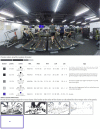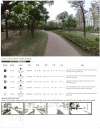Outdoor walking better? environmental elements of cardiorespiratory fitness training trails
- PMID: 36699982
- PMCID: PMC9870626
- DOI: 10.3389/fspor.2022.1036777
Outdoor walking better? environmental elements of cardiorespiratory fitness training trails
Abstract
In metropolitan areas where land resources are scarce, trails are a more suitable environment for cardiorespiratory fitness training for modern people. Previous studies have demonstrated that cardiorespiratory fitness is an important factor in assessing individual health and have focused on individual training performance, but the relationship between environment and cardiorespiratory fitness training participants has rarely been investigated. The purpose of this study was to investigate the demands for outdoor cardiorespiratory fitness training and a favorable trail environment by comparing the differences in exercise intensity and perceptions between outdoor and indoor environments. In this study, information on physical data, psychological feedback, and visual atmosphere was collected from nine participants during each phase of moderate intensity cardiorespiratory fitness training in indoor and outdoor environments. The results revealed that outdoor cardiorespiratory fitness training provided participants with lower training intensity during the active exercise phase and higher heart rate during the stretching phase compared to indoor training. The participants paid more attention to the slope, length, pavement, Spaciousness, and width of the trails and the circuitous route. The change of the visual atmosphere and the scenery for the environmental factors were the important factors to motivate the participants to train. The results of the study could assist participants to understand a favorable cardiorespiratory training environment and design a suitable training program, as well as provide a model for trail planning and design for government.
Keywords: cardiorespiratory fitness training; environment factor; indoor health and fitness club; outdoor trail; visual atmosphere.
© 2023 Li, Lee and Tsang.
Conflict of interest statement
The authors declare that the research was conducted in the absence of any commercial or financial relationships that could be construed as a potential conflict of interest.
Figures





References
-
- Raghuveer G, Hartz J, Lubans DR, Takken T, Wiltz JL, Mietus-Snyder M, et al. American Heart association young hearts athero, hypertension and obesity in the young committee of the council on lifelong congenital heart disease and heart health in the young. Cardio. Fitness Youth. (2020) 142(7):e101–18. 10.1161/CIR.0000000000000866 - DOI - PubMed
-
- World Health Organization. Guidelines on Physical Activity and Sedentary Behaviour: at a Glance (2020). Available online at: https://apps.who.int/iris/bitstream/ handle/10665/337001/9789240014947-c... - PubMed
-
- Chiang YC, Weng PY. More walking and healthier living: the relationship between walkable environments and residents’ health. J Outdoor Recr Study. (2012) 25(4):25–50. 10.6130/JORS.2012.25(4)2 - DOI
Publication types
LinkOut - more resources
Full Text Sources

